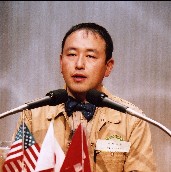��Looking for Robinson Crusoe��
November 8, 2006
Mr. Daisuke Takahashi,
Explorer and Novelist
 There was a real-life model for ��Robinson Crusoe,�� written by Daniel Defoe, 300 years ago. It is Alexander Selkirk, a Scottish man of a small fishing village named Largo. His birthhouse is still in Largo and his bronze statue is stood in font of the house. Also in Scotland, four items that he used-coconut-carved cups, a wooden chest to store his personal articles, a gunpowder box for his matchlock, and a knife handle-are being kept as part of a collection.
There was a real-life model for ��Robinson Crusoe,�� written by Daniel Defoe, 300 years ago. It is Alexander Selkirk, a Scottish man of a small fishing village named Largo. His birthhouse is still in Largo and his bronze statue is stood in font of the house. Also in Scotland, four items that he used-coconut-carved cups, a wooden chest to store his personal articles, a gunpowder box for his matchlock, and a knife handle-are being kept as part of a collection.
In 1704, just about 300 years ago, Great Britain hired pirates under the name of the King of England, allowing them to rob in the South American waters of Spanish territory. Alexander Selkirk was one of the men wanting hefty profits by committing robberies on the waters. He arrived in the sea around the South American Continent and landed in the isolated island-currently called ��Robinson Crusoe��-in Chile territory in 1704. In the novel, whereas its main character ��Robinson�� was drifted to the island, Selkirk actually left the boat ashore after fighting with the ship��s captain and landed in the island. His thought that a rescue would come soon was off target, forcing him to live the island for four years and four months in the end.
At that time, the island was called ��Juan Fernandez,�� which has now a fishing village named San Juan Bautista and is no longer a deserted island. The entire island is a national park and maintains the relatively same undeveloped nature about 300 years, except for the village.
I have spent time on the island 13 times since 1944 and explored how Selkirk lived. In the ��Robinson Crusoe,�� five requirements are declared for someone to live its life in the desired island.
Requirements to survive in the island:
1)Live near water.
2)Able to secure food easily or easy access to the sea.
3)Secure a flat land to build a house.
4)Live near observatory for a rescue boat.
5)Hold another place to hide for unexpected enemies.
Before starting to probe his life, I inferred that Alexander Selkirk had lived in the area, which satisfied the five requirements.
A single clue or one of Selkirk��s principles to start exploring is the so-called ��Selkirk��s Watch Bench,�� which is in the center of the island and in the upland of 565 meters from the ground. It was an ideal observation post to seek a rescue ship in all directions. From this starting point, I set my direction to find the other four of his survival points.
My first probe in 1994 was a complete failure. In a few attempts after 1994, I encountered an old man who said he knew a house in a bush. The man guided me, and I found the remains of a rockwork house. With the location very close to the Watch Bench, I was convinced to a certain extent that this is the place where Selkirk actually lived. Then I asked help from the expedition club in New York and the National Geographic Society, and orchestrated an international expedition team of Chilean, English, and Japanese to unveil the site, the exploration of which continued until February 28 from January 6, 2005.
After identifying the rockwork house as ammunition storage built by Spanish in 1750, we decided to dig further under the warehouse with an expectation of discovering something related to Selkirk, and found two primitive marks of a fire being set and several holes of columns being arranged as if surrounding the fire point. Through a sand strainer, we also found a tip of a pin, only with a 16mm length for a navigational compass. Because records still exist that Selkirk was once a ship��s mate and possessed equipment for that role, we determined that these findings are related to the life of Selkirk at his house.
I would like to protect and preserve, as my mission, the house of ��Selkirk�� in the shining national park, because his place is a real life model of the famous ��Robinson Crusoe.�� Also my dream to make the place a sanctuary for people to learn how a person could survive by themselves in the wild is growing.